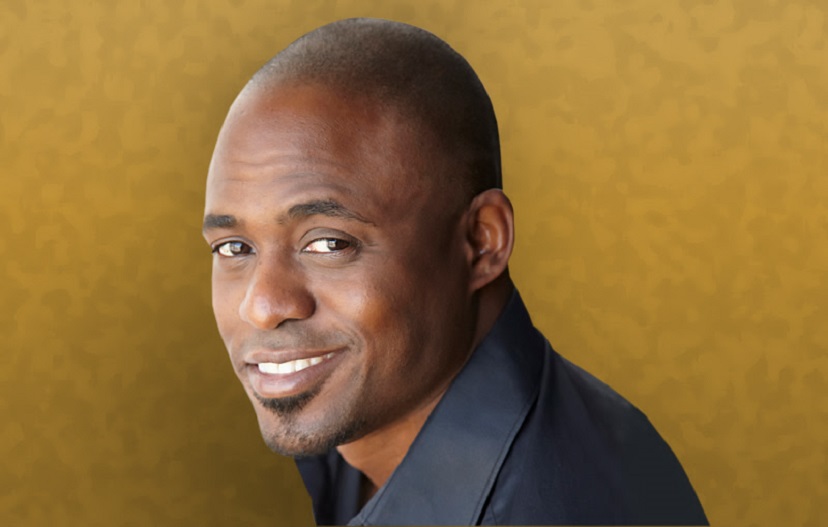

Features
Regina Taylor Examines Legacy & Digital Technology In Stop. Reset.
Published
11 years agoon
Broadway Black was honored to speak with Regina Taylor about her new production, Stop. Reset., and the importance of legacy in this age of digital technology. The following are excerpts from that conversation.
Broadway Black (BB): Stop. Reset. is your 12th Goodman Theatre production. You are celebrating your 20th anniversary at the Goodman Theatre as an Artistic Associate. What is the secret to your longevity?
 Regina Taylor (RT): I feel that it’s been such a rare and wonderful treat at the Goodman Theatre and having longevity with an institution such as the Goodman. It is rare for any artist, especially a Black person, especially a Black woman, to be able to grow each year in developing one’s own voice. What is unique and special about that which you bring, what is your authenticity of full self that you bring to life and to your pieces? My pieces are markers in my life. I have been challenged in life and I challenge life with each and every piece. There is an opening to dare in each and every piece. With this one, I feel like I’ve learned everything along the way that I’m bringing fearlessly with my own tongue. Think about Miles Davis, you know who he is by that first note. That takes sounding like other people until you hit it and know that it’s yours. With this piece, I know that it’s mine. It’s an idiom of jazz. Each character is mine. In this piece there is an element of Afro-Futurism that harnesses both past and present when looking at who we are and how we survive into the future. It resonates with how we deal with what we’re dealing with right here and now and who we are. Who are children will be.
Regina Taylor (RT): I feel that it’s been such a rare and wonderful treat at the Goodman Theatre and having longevity with an institution such as the Goodman. It is rare for any artist, especially a Black person, especially a Black woman, to be able to grow each year in developing one’s own voice. What is unique and special about that which you bring, what is your authenticity of full self that you bring to life and to your pieces? My pieces are markers in my life. I have been challenged in life and I challenge life with each and every piece. There is an opening to dare in each and every piece. With this one, I feel like I’ve learned everything along the way that I’m bringing fearlessly with my own tongue. Think about Miles Davis, you know who he is by that first note. That takes sounding like other people until you hit it and know that it’s yours. With this piece, I know that it’s mine. It’s an idiom of jazz. Each character is mine. In this piece there is an element of Afro-Futurism that harnesses both past and present when looking at who we are and how we survive into the future. It resonates with how we deal with what we’re dealing with right here and now and who we are. Who are children will be.
BB: Tell us about your latest work, Stop. Reset.
RT: Stop.Reset. is about 70-year-old Black bookstore owner Alexander Ames. He is trying to determine how to keep his business from being extinct. He is a lover of books. What they hold, their weight, smell and feel. Memories from the ancestors is what they hold. How they are transferred, palm to palm. He’s trying to figure out how that moves forward in the digital age. What does he need to hold onto and what does he need to let go? All of Ames’ bookstore workers are over 40 except one, J the 19 year old, who is semi-literate. So there is a generational conversation about the present and the future. Ames sees promise in J and recognizes himself, but J is interested only in the present and the future, not the past.
It’s about books but also about how we deal with change. There are so many changes we’re grappling with in the present moment. People don’t change easily. People dig in their heels to figure out where they stand and fight for what they believe in and what they know, as the terrain is shifting, and we can’t trust the dirt under our feet. People either dig in or dive headlong into the unknown and embrace it. Stop. Reset. is not just about technology, but about where we are. It’s about race, gender, sexuality, the economy, all of these issues as they are shifting right now in terms of how we look at things. Who are we becoming? Who do we want to become?
The play is about what the audience brings to it in terms of their own history. What I set is conversations, arguments, dialogue, about how you deal with change. I try to give equal weight to various perspectives. Some will enter and be moved in terms of where they stand. Others may dig in and not move. What I hope to spark, to provoke, is the dialogue to look at the world and themselves. The question of the ground that we stand on. That’s the first spark of change. Or not. {Referencing Dr. Martin Luther’s Speech after the march from Selma to Montgomery, Alabama in 1965}: How long? Not long. How long has it been? We keep coming back to that phrase in different increments in time. Is it possible to escape one’s past and all that it brings? To escape the shadows that we drag behind us? I present the question for the audience to answer for themselves.
BB: Stop. Reset. is, in part, about the digital age and how that reflects the information we receive from various sources. How do you perceive the role of digital technology, especially as it relates to breaking news that reflects the African American community?
RT: There is great possibility. Digital technology has changed how we talk about race. Who owns the narrative? How Black males have historically been presented in the media. Here and now, there’s a transformation in terms of the tongue. Who’s speaking about it, who gets to frame the narrative? There is a “Stop and Reset” in the narrative that came from the ground, meaning the grassroots and social media. Once the floodgates opened, the mainstream had to follow. So there were more layers to that story than we expected. We’re seeing how these devices are being harnessed for our community, like #BlackLivesMatter. This is where we want to talk.
We are the ones who should be telling our stories. There is an opening for books. We have the spoken word and people would gather around the fire for the gatekeeper to tell the story. When books came along, we the masses would hold the knowledge with the ability to read. The hierarchy has been toppled. Who are we becoming with people alone with a book, cut off from the world? On the contrary, people are talking to their devices and these worlds open up to the masses. The gatekeepers are being toppled. Whose voice should be voiced and heard? Everyone has access. That’s the powerful part. How do we harness this power? How do we learn how to learn from this device? How do we teach ourselves the weight of each piece of the information without someone over us telling us which way to go? The opening is amazing. We can and have been telling our own stories. It’s about how we harness them.
BB: One of the questions that Stop. Reset. asks is whether books are obsolete. There are so many fewer African American newspapers and bookstores than there were twenty or fifty years ago. Is it just as important in what medium our stories are told?
RT: I look at adaptation and meeting new audiences. What does this technology bring? Who are these new audiences and how one shapes the others? Ebony, Jet, Haki Madhubuti are all examples of those who champion the written word. And what doors those magazines opened to me as a child in Dallas, Texas. Looking at how they framed the discussion of Black is Beautiful and how powerful those images were to me as a Black female moving forward. The diversity of identity opening that lens in terms of the world and how I saw myself. How those stories weren’t the same as those in the mainstream that reflected who I was, am, and can be. The importance of periodicals giving a reflection of self. How do you reflect that here within? Certain things can be erased if not held in a book. How do you pass that on so the legacy isn’t lost? What do we need in terms of that legacy? We need certain parts of our past, the understanding of how we’ve adapted all along. We will continue to adapt. We have continued to adapt and survived against all odds.
BB: You’ve described yourself as a purist when it comes to books, yet the StopReset.org website is revolutionary in what it offers theatregoers and the community at large with in-theater tweeting and live community discussions. What is your response to those who say that attending the theatre should be a static, as opposed to an interactive, experience that Stop.Reset provides?
RT: We continue to update the StopReset.org site. The audience gets to have the choice, according to their perspective. They can choose where they enter the play: before the show happens, while at the theater, and afterward. It’s organic in that it’s the melding of reality. We are meeting Chicago audiences on their own ground. Stop. Reset. is a piece about Chicago and the dialogue converges so the audience is a part of the play itself, wherever they are. I’m finding this liberating. I’m growing so much.
BB: There were two Outside the Box events this week in which those involved with Stop. Reset. interacted directly with the Chicago community. What did you glean from those discussions?
RT: The symposia are about change. Everyone has been hit by technology in some way. Having these conversations with people from diverse backgrounds and to engage with artists around Chicago, professionals, and, importantly, students, that they take the themes of the play and create their own pieces and do it through their own medium: play, spoken word, music. All of that we’re doing in these live interactions.
A chord has to be struck that people need to be dealing with what is going on at this time. I don’t think we’ve seen such overall social and technological change since the 60s, when people were walking on the moon and sitting on the ground. All things are erupting at this moment. The LGBT community’s rights still, still gender, still race. Haven’t we been through this? When will we move forward? What do we need to move forward with? Do we cut a way the ghosts and leave the past behind? What do we need to retain? What are the tools that we need to move forward?
way the ghosts and leave the past behind? What do we need to retain? What are the tools that we need to move forward?
BB: Stop. Reset. is, in part, about legacy. With your decades at the Goodman Theatre and as the only member of the theater’s Artistic Collective to generate work in all three creative capacities as playwright, director and actor, how are you defining your legacy and what advice could you give young Black women creating their own work?
RT: There is a passion and tenacity to it. A seeking of truth to it. An unstoppability in terms of claiming ground and being heard and being seen. To claim the ground that sheds light to your existence. That’s what my work is about, in terms of reaching out to the community to give platforms to people who would not have visibility. That Stop. Reset. is set in Chicago and my relationship to audiences who have witnessed these markers in my life. The challenge is to see how I can extend these portals of storytelling as an artist to work along with the community. It permeates every part of our lives. How to challenge audiences and interact with new audiences.
Regina Taylor is a Golden Globe and NAACP Image Award winner and two-time Emmy Award nominee currently starring in DIG, a new television series on USA Network. She was the first African American to play Romeo and Juliet’s title young lover on Broadway, and gained wide public recognition for her performance on the television series, I’ll Fly Away. Taylor’s latest stage production, Stop. Reset. can be seen at Chicago’s Goodman Theatre from May 23 – June 21.
You may like
Features
Photo Exclusive: Step into The Light with Broadway Black
Published
7 years agoon
February 21, 2019
Have you seen The Light by Loy A. Webb at MCC Theater? If you haven’t, then you need to and Broadway Black has got you. Join us on SUNDAY MARCH 3rd for the BWAYBLK Experience!
Use code BWAYBLACKMCC and pay $35 for any seat on Mar 3 at the 7:30 performance
Not every marriage proposal goes as planned. LOY A. WEBB’s THE LIGHT introduces us to RASHAD and GENESIS on what should be one of the happiest days of their lives, but their joy quickly unravels when ground-shifting accusations from the past resurface in this gripping two-character drama. Can their relationship survive the growing divide between them over who–and what–to believe?
Also, get into this amazing photo series of playwright Loy A. Webb & the cast of her play The Light. Photos by Curtis Brown were taken in the new elegantly designed and strategically welcoming Robert W. Wilson MCC theater space. Located in midtown New York on 52nd and 10th ave (511 W 52nd ST
New York, NY 10019)
On another tip, some really dope creatives will do a talkback after the Saturday matinee performance that you might be interested in attending. Make sure to RSVP.
Panelists include: Nissy Aya, Cristina Pitter, Alicia Rodis & Kavita Mehra
THIS WEEKEND SAT FEB 23rd
LOY A. WEBB’s THE LIGHT at MCC Theater delves deeply into one couples’ reckoning with an encounter with sexual violence that has left audiences asking: as a partner, a family member, a friend, how do we support sexual assault survivors? And what responsibility do artists have to create work that is trauma-informed? On SAT FEB 23 at 4:00 PM for an in-depth conversation about the power of allyship rooted in love and healing – in our lives and on our stages – in the face of trauma.
SAT FEB 23 at 4PM
THE ROBERT W. WILSON MCC THEATER SPACE
511 W52 ST
RSVP HERE.
Features
A Superhero On & Off The Stage, Camille A. Brown Brings ink
Published
7 years agoon
February 5, 2019

Camille A. Brown Photo by Whitney Browne
Camille A. Brown‘s dance company, Camille A. Brown & Dancers, tours nationally and internationally and will be presenting six performances featuring the debut of ink at The Joyce Theater NYC Feb 5-10th 2019.
Propelled by the live rhythms and sounds of traditional African and handmade instruments, Camille A. Brown’s ink celebrates the rituals, gestures, and traditions of the African diaspora. Highlighting themes of brotherhood, community, and resilience, the work seeks to reclaim African American narratives and is the final installment of Brown’s dance theater trilogy about identity.
In addition to her company works, Ms. Brown brings her passion for storytelling to her award-winning choreography for Broadway, Television, and Off-Broadway. Productions include Tony Award Winning Once On This Island, (Drama Desk, Outer Critics and Chita Rivera award nominations), Emmy Award Winning Jesus Christ Superstar Live on NBC, A Streetcar Named Desire, Choir Boy, the upcoming Magic Mike The Musical, PAL JOEY.
We had the chance to probe a little bit into the world of Camille A. Brown, and we’re grateful for the insight and wisdom with which she was able to bless us. Check out the interview below along with an excerpt from ink.
Broadway Black (BB): After forming the idea, what was the process of building ink?
Camille A. Brown (CAB): After the creative process for BLACK GIRL: Linguistic Play, I held a desire to dig even deeper and tell more stories of ritual, gestural vocabulary, and traditions of the African Diaspora. I was immediately drawn to two albums that had a significant impact on me when I was growing up. The Miseducation of Lauryn Hill by Lauryn Hill, and Like Water for Chocolate by Common. I tasked myself with creating a movement language that embodied the same raw authenticity, and vulnerability that fuels those lyrics and music.
As I began to develop the concept for ink, I wanted the dancers to represent superheroes. I couldn’t figure out why I had the urge to play with this idea until I read Question Bridge: Black Males in America. One of the men interviewed said, “I see Black people as comic book heroes because they always keep rising.” That was it! It is about showing that in our basic survival, and natural attributes we have superhuman powers. Powers to shift, overcome, transform, and persevere even within an often hostile environment. The seven sections of ink represent super powers of spirituality, history and heritage, the celebration of the Black female body, Black love, brotherhood, exhaustion, and community.
The process involves a deep collaboration with the dancers and my direction is guided by their choice making.
The space is very organic and fueled by research. My dancers, musicians, dramaturgs, and I are in constant dialogue throughout the process about the work and how it’s progressing. We don’t move forward unless we’re all on the same page.
We are building the work together. As a disclaimer, I let everyone know the process will be exceptionally tedious. Like a fine comb, I go through each beat, gage the temperature of storylines, and make sure the movement and music are always in conversation (whether aligned or in contrast).
BB: What made you want to start your own dance company and how have you sustained?
CAB: I found my love of choreography in college because I struggled with body image, and found that creating my own voice was a safe and empowering space. After graduating, I danced with Ronald K. Brown/Evidence for 5 seasons and during my second year with The Company, a friend from college (Amy Page) sent me a flyer for the Hubbard Street 2 competition which picks 3 choreographers to create work on the Company. I was chosen! That gave me the encouragement to pursue choreography. My first idea was to take an alias like female writers used to do because even at 22, I knew the playing field was not leveled and women (particularly black women) did not get as much exposure as male choreographers. Dance is revealing and vulnerable so taking an alias wasn’t a realistic option. People would have to see me as I am, but I also needed the confidence to withstand the obstacles. Not only that, having a company seemed daunting.
Ron wore so many hats. He was the director, choreographer, teacher, and also took on administrative duties. He never got a break. I wasn’t confident I could handle all of the duties.
I set work on other companies, but soon realized it wasn’t for me. 1-4 weeks working with a Company wasn’t enough time for me to really hone my skills, find my voice, and discover my personal creative process. I desired a more intimate relationship and space with my dancers and collaborators. I had my first show at Joyce SoHo in 2006, and committed to having a company in 2010.
What sustains CABD is my team. I have a company agent (Pamela Green), Managing Director (Indira Goodwine), Company Manager (Michelle Fletcher), and a production team who holds things down.
In the beginning, I was doing ALL the jobs! As time went on, my team slowly formed. It’s really about patience and perseverance. Nothing happened over night and everything is a progression.
BB: How have you had to be a superhero in your own life personally and professionally?
CAB:
Personally
Last year, I had a life-threatening experience. My appendix ruptured on tour. Appendicitis is when they remove your appendix before it ruptures, but mine actually did and the fluid was in my system for at least a week. I survived the “fatal” stage- which the doctors told me isn’t common. This started a very long year and a half which included 4 hospital stints and two surgeries (my second one was in April). This all happened during Once on This Island (I was in the hospital the first week of rehearsal and had my first surgery during tech), Jesus Christ Superstar Live, and my Company touring. I had to access my “superpowers” and push through, but thankfully I had my team and community to help me.
I’m going to be writing about the entire ordeal because it was such an integral part of my life. People see the “success”, but if they only knew the hardships I had to overcome to get to the other side.
Professionally
Being a Black female Choreographer and Director is hard. People ask me to do I feel like I’ve arrived. Absolutely not. I’m still Black and a woman- two underrepresented groups- particularly in theater. The playing field is still not leveled and I’m clear I have to work twice as hard.
I’ve had to build up strength and confidence. It is an ongoing process of gathering those superpowers. In many spaces, I’m sometimes the only woman (I was the only woman on the creative team for Jesus Christ Superstar Live), and the only black person in some rooms.
Recently two black girls at different events asked me the same exact question: How do you navigate spaces where you’re the only one.
It’s quite easy to feel intimated and shrink yourself. I know I have done that in the past. Now, I’ve found if I think about the black women before me in similar spaces, black women who are currently in similar spaces, and the next generation of black women coming after me, it makes me more confident. When it’s not just about you, it becomes a responsibility.
And even when I don’t feel like I have any superpowers, this happens…
and it refuels and encourages me to keep going. Someone is always watching.












